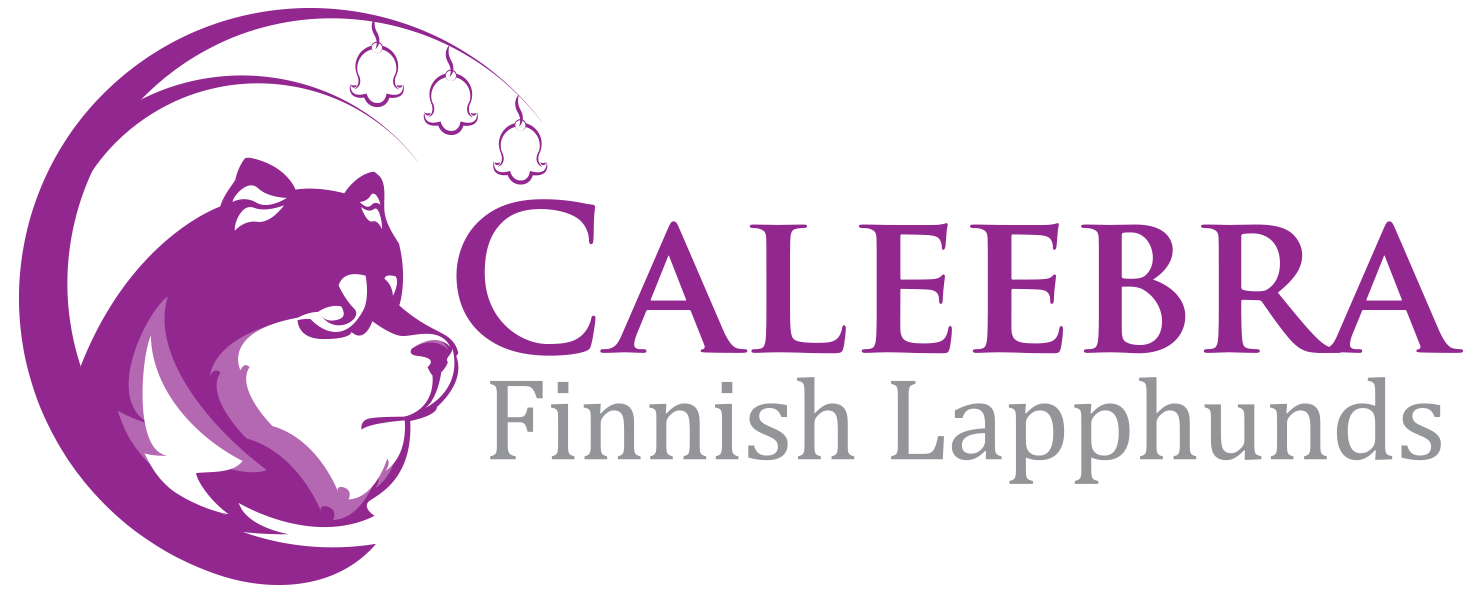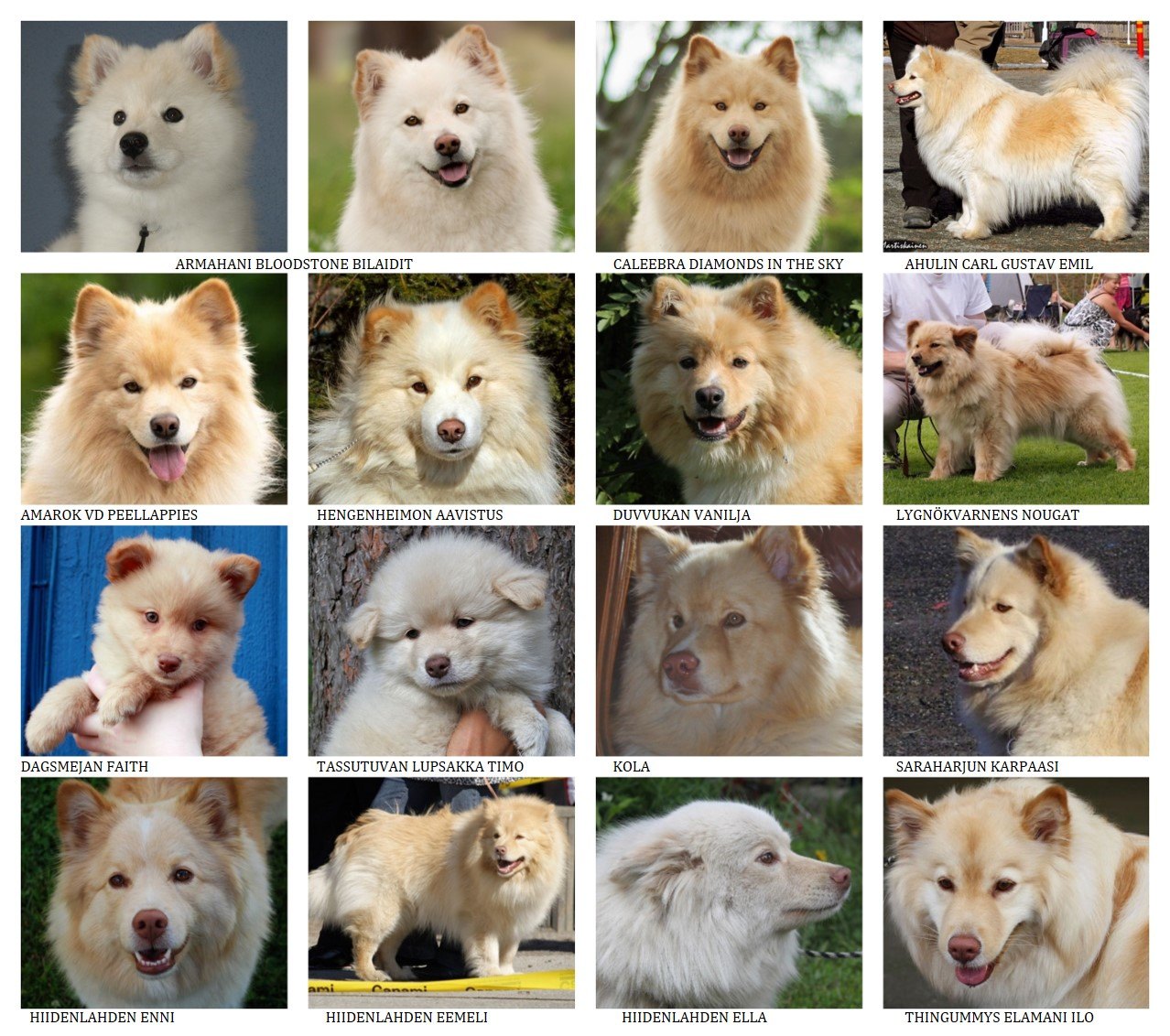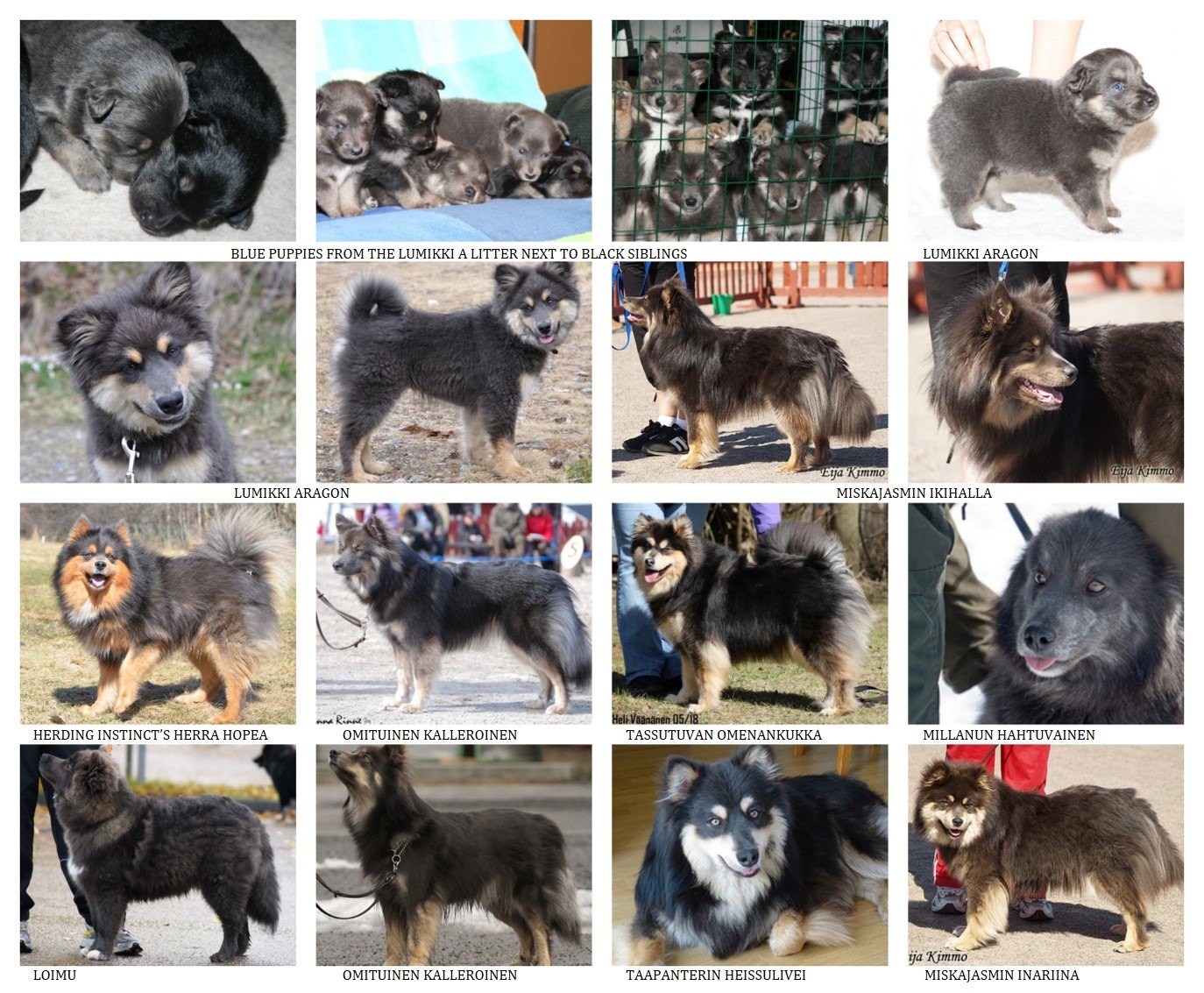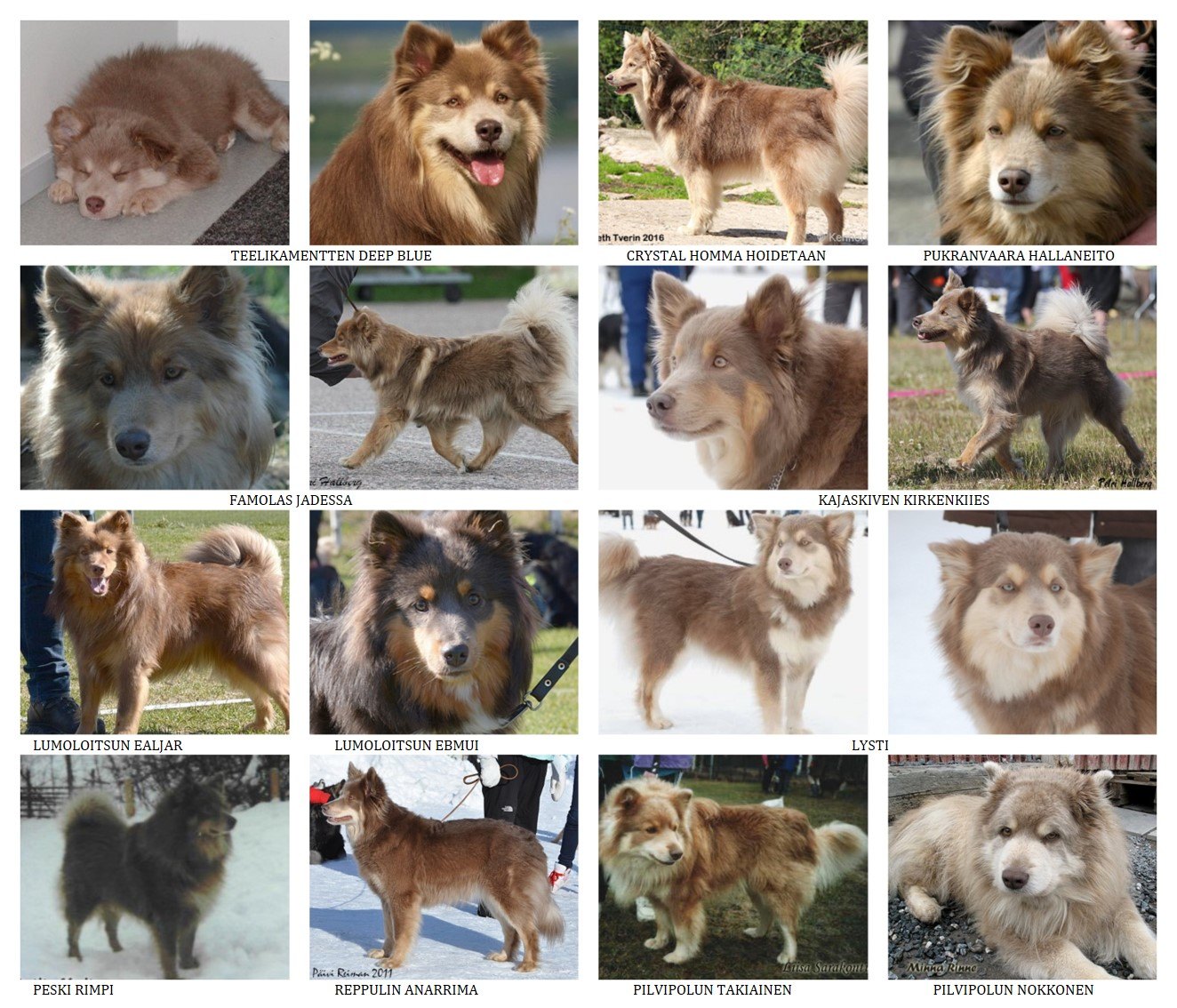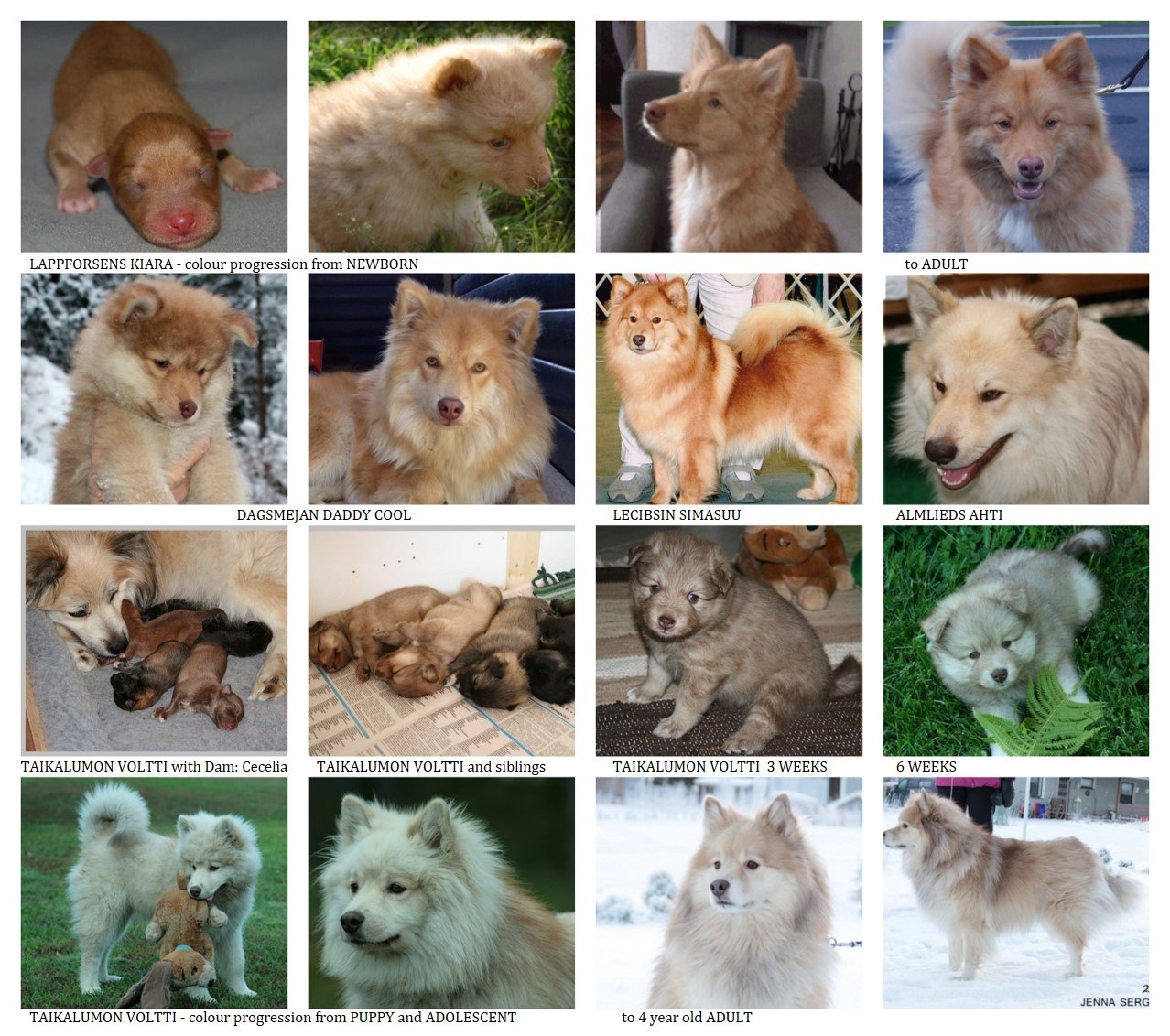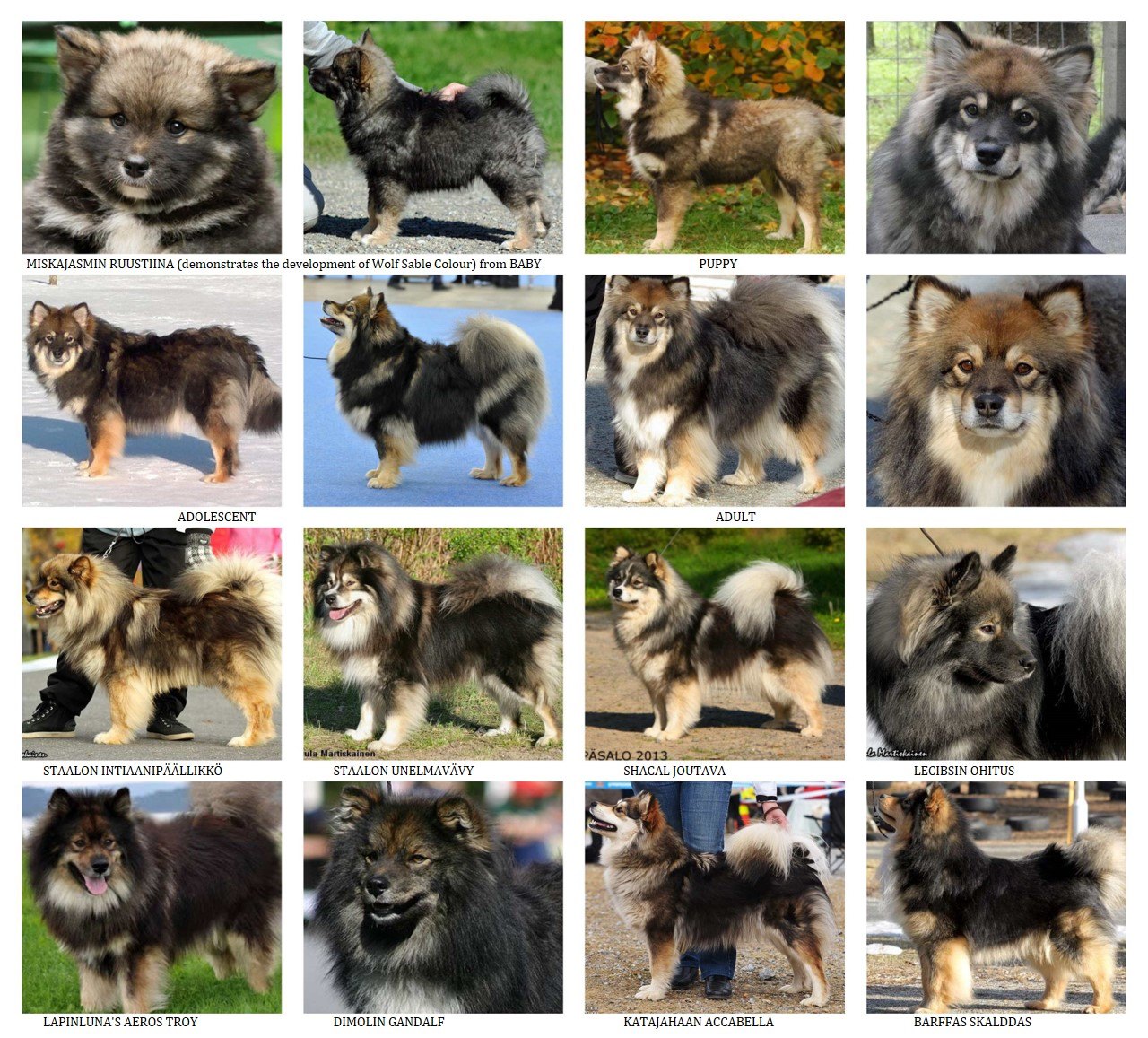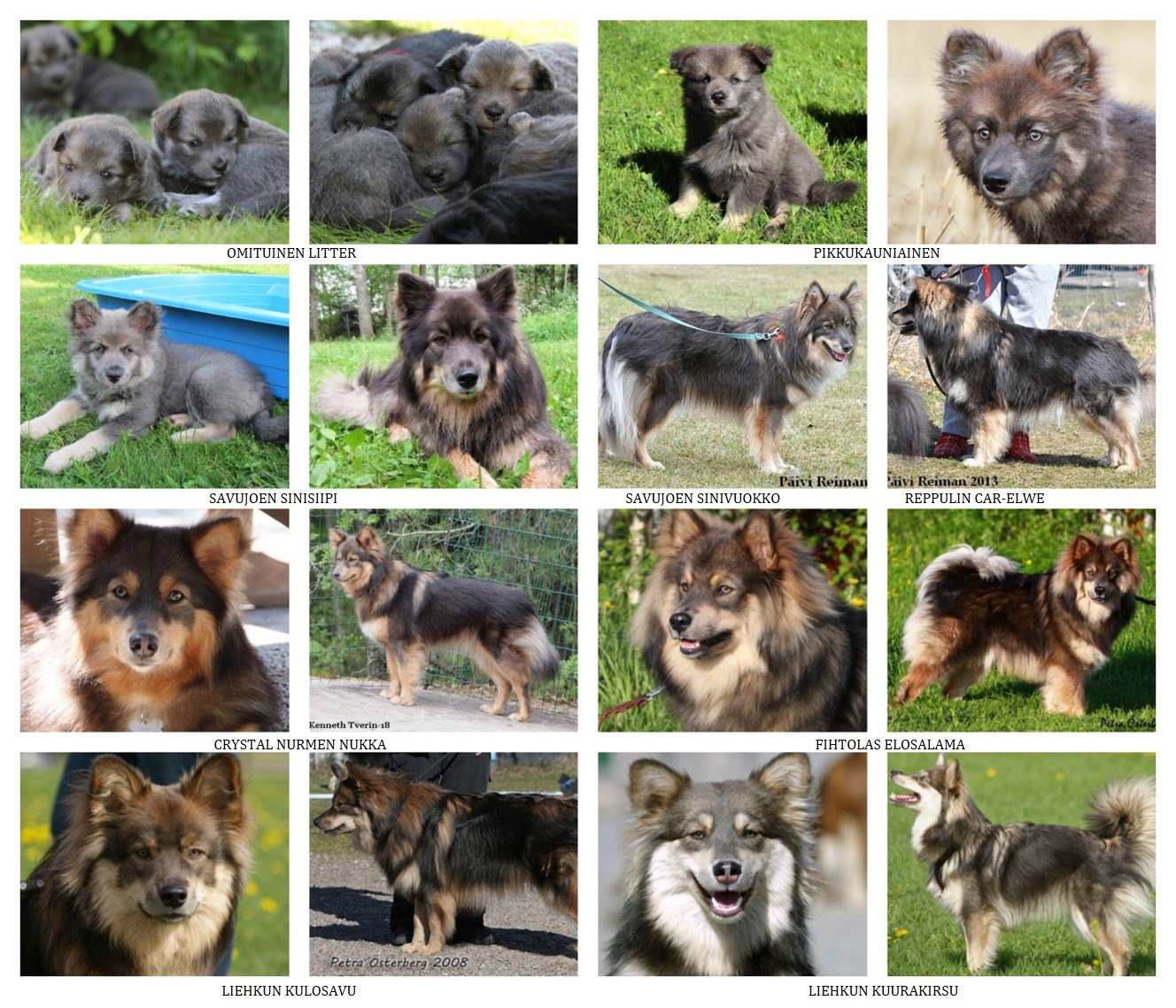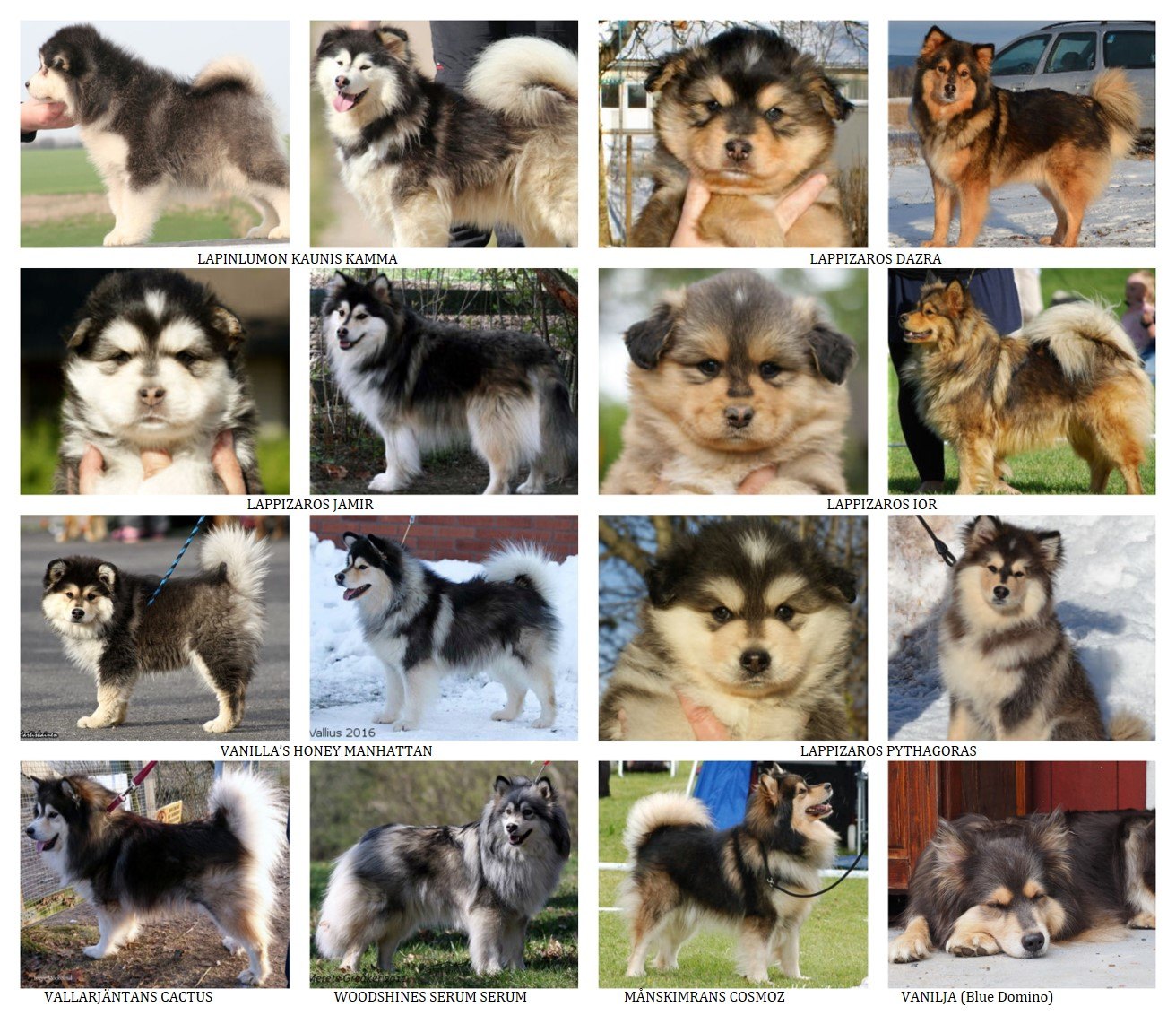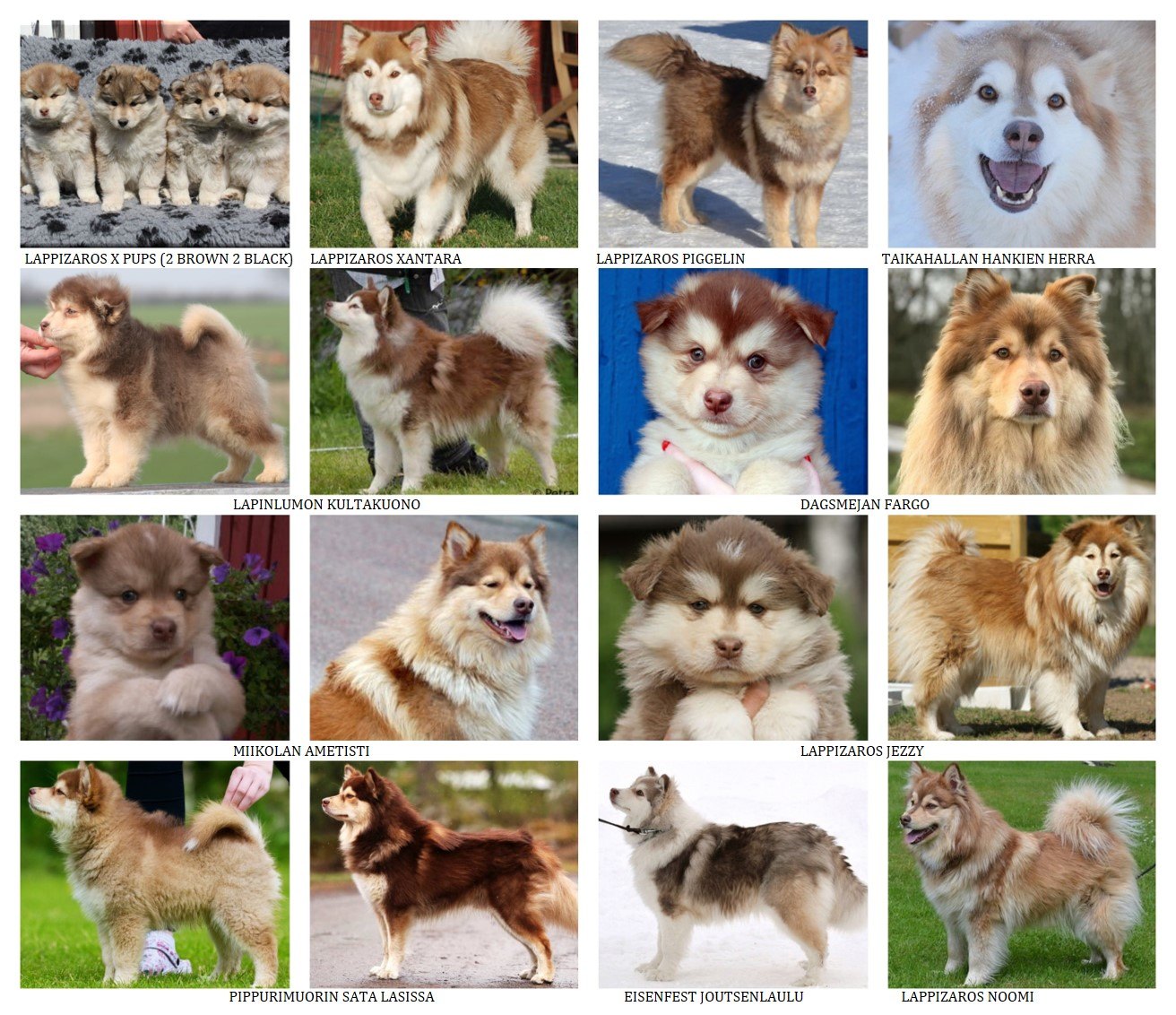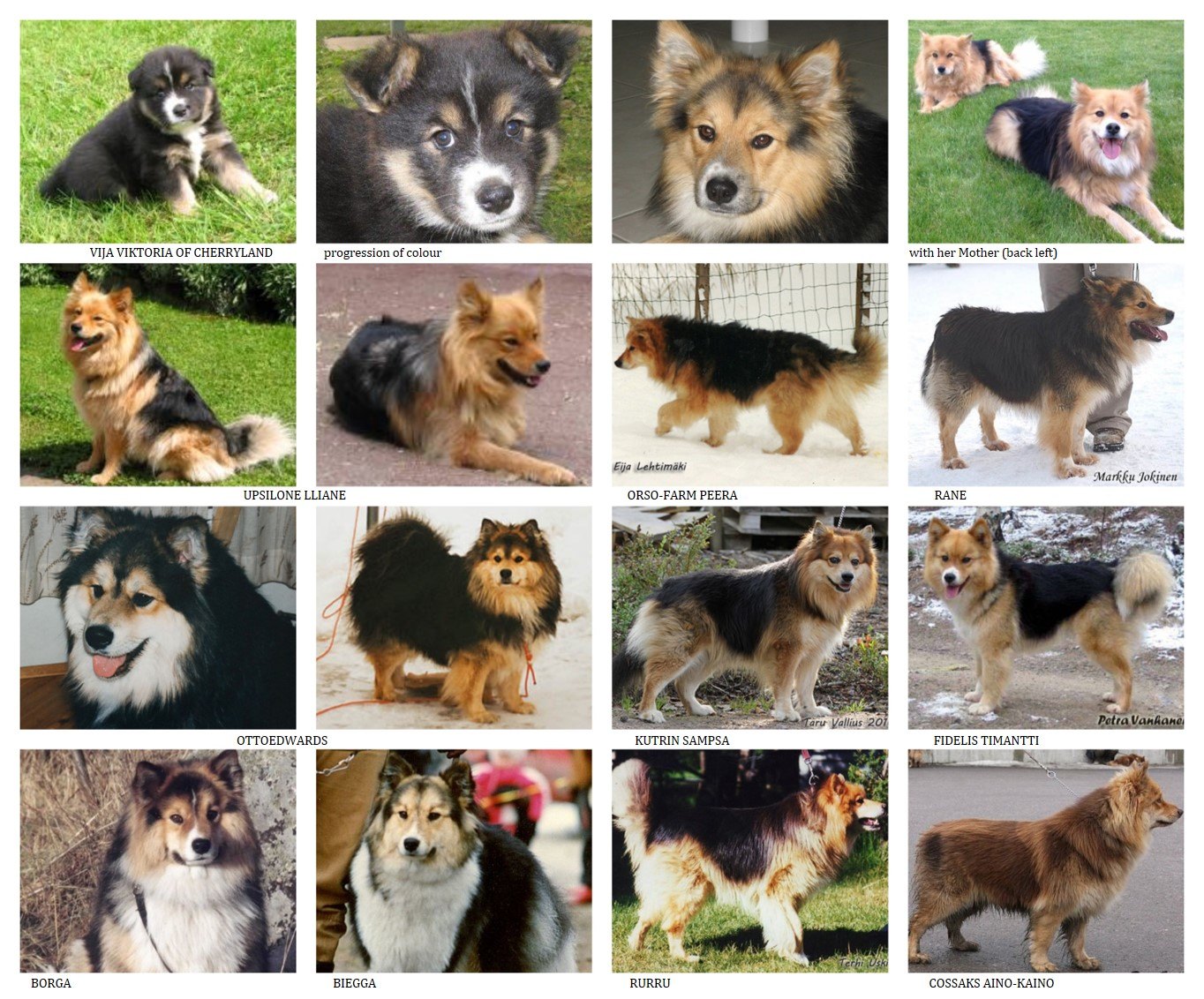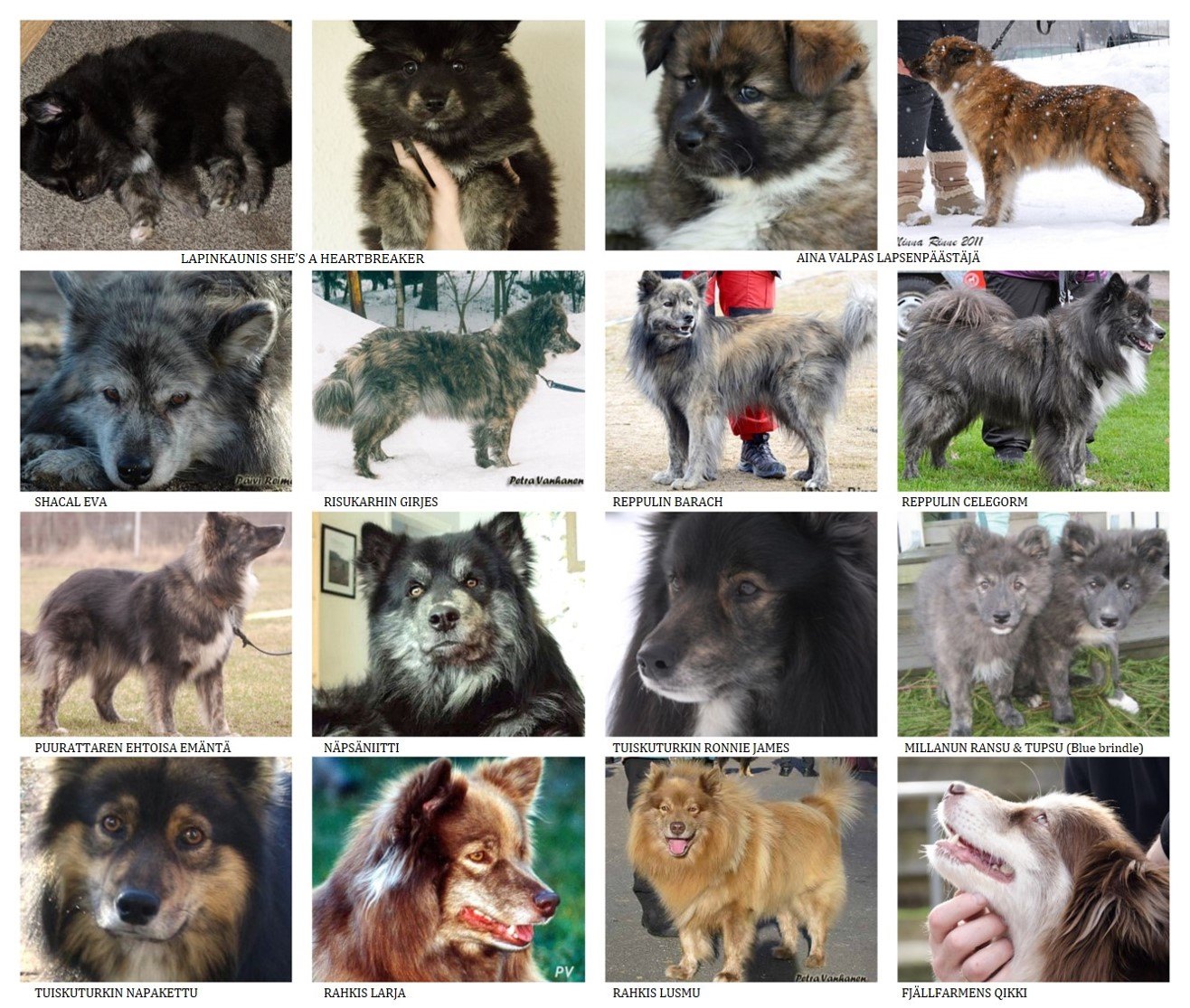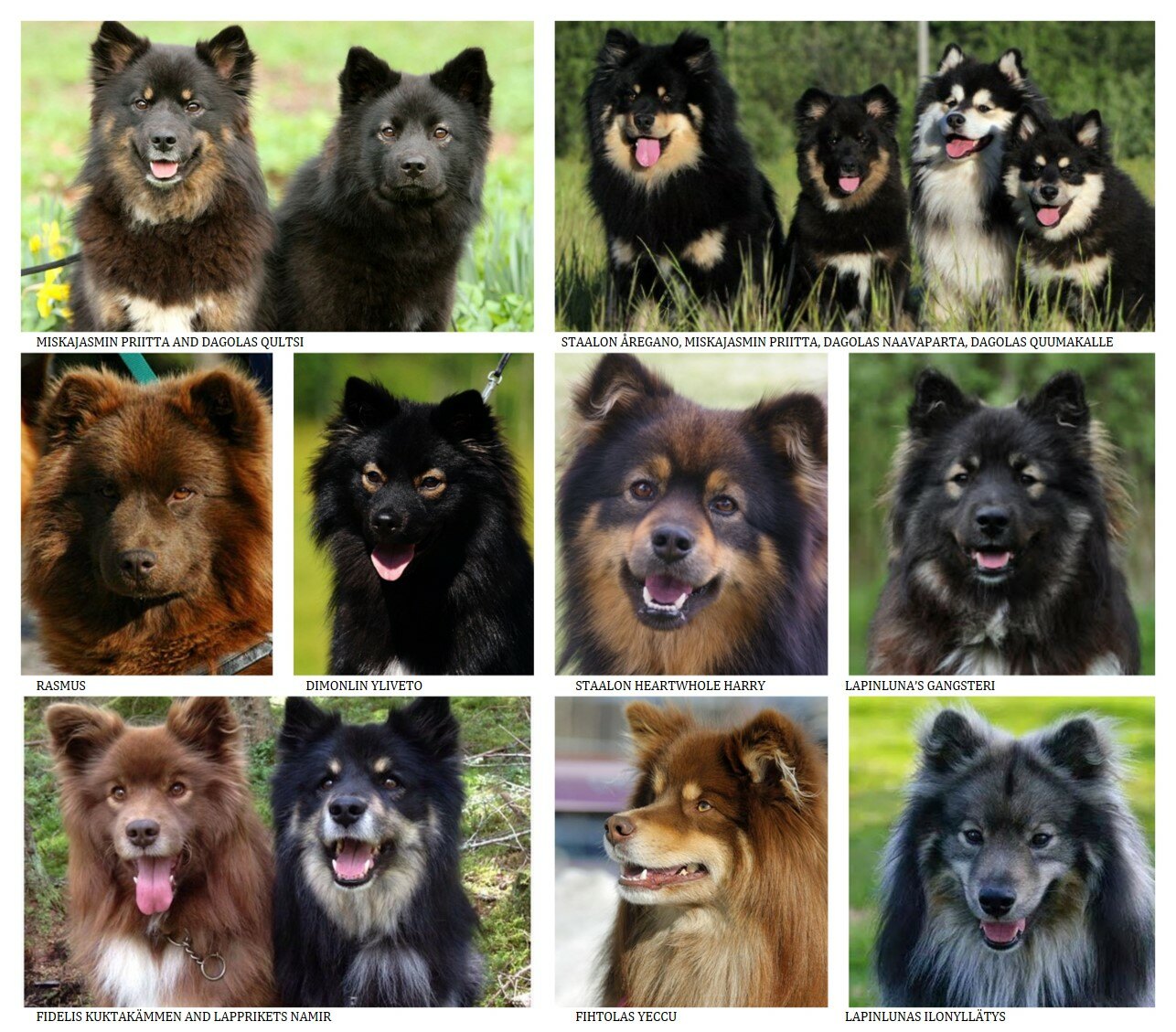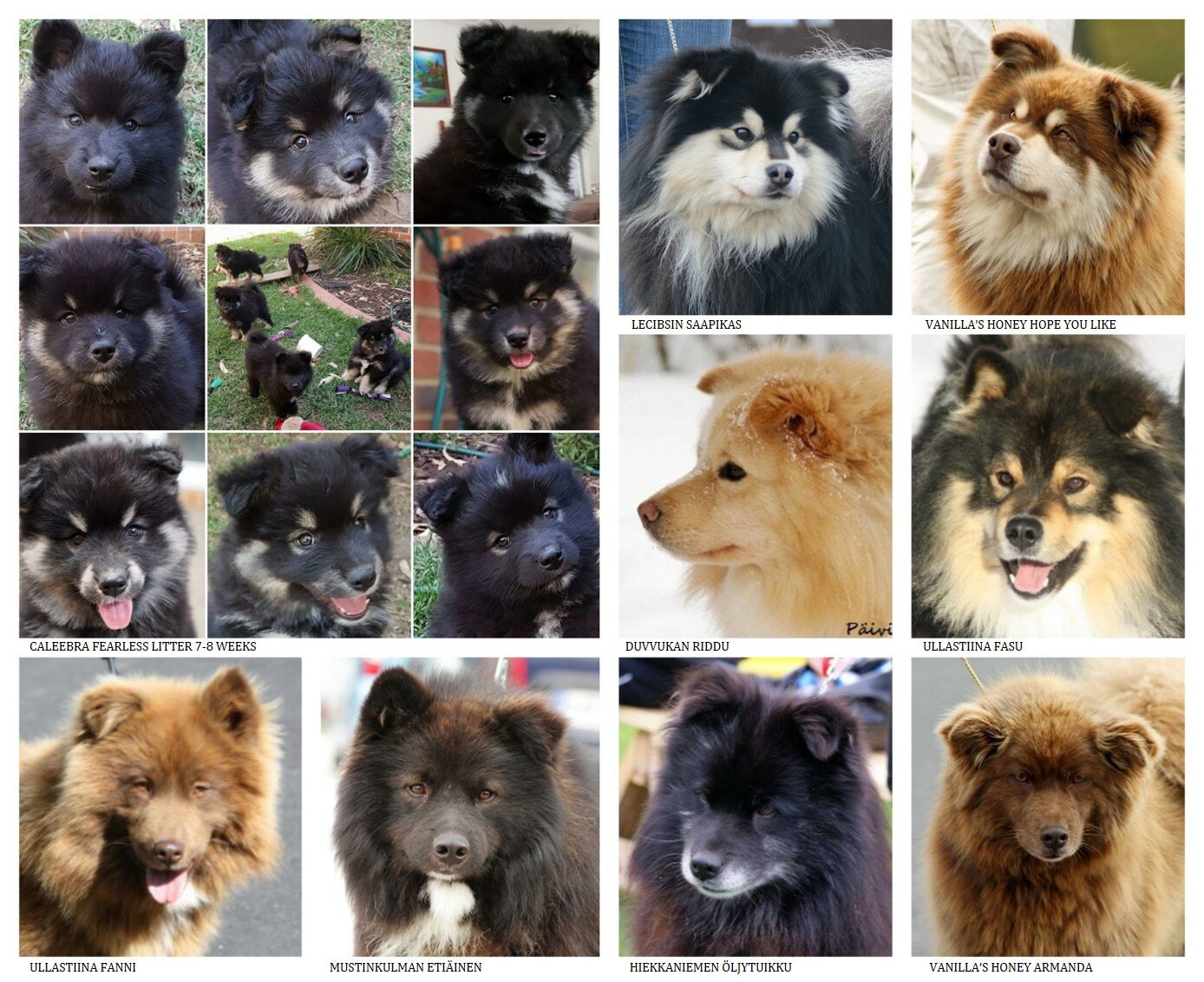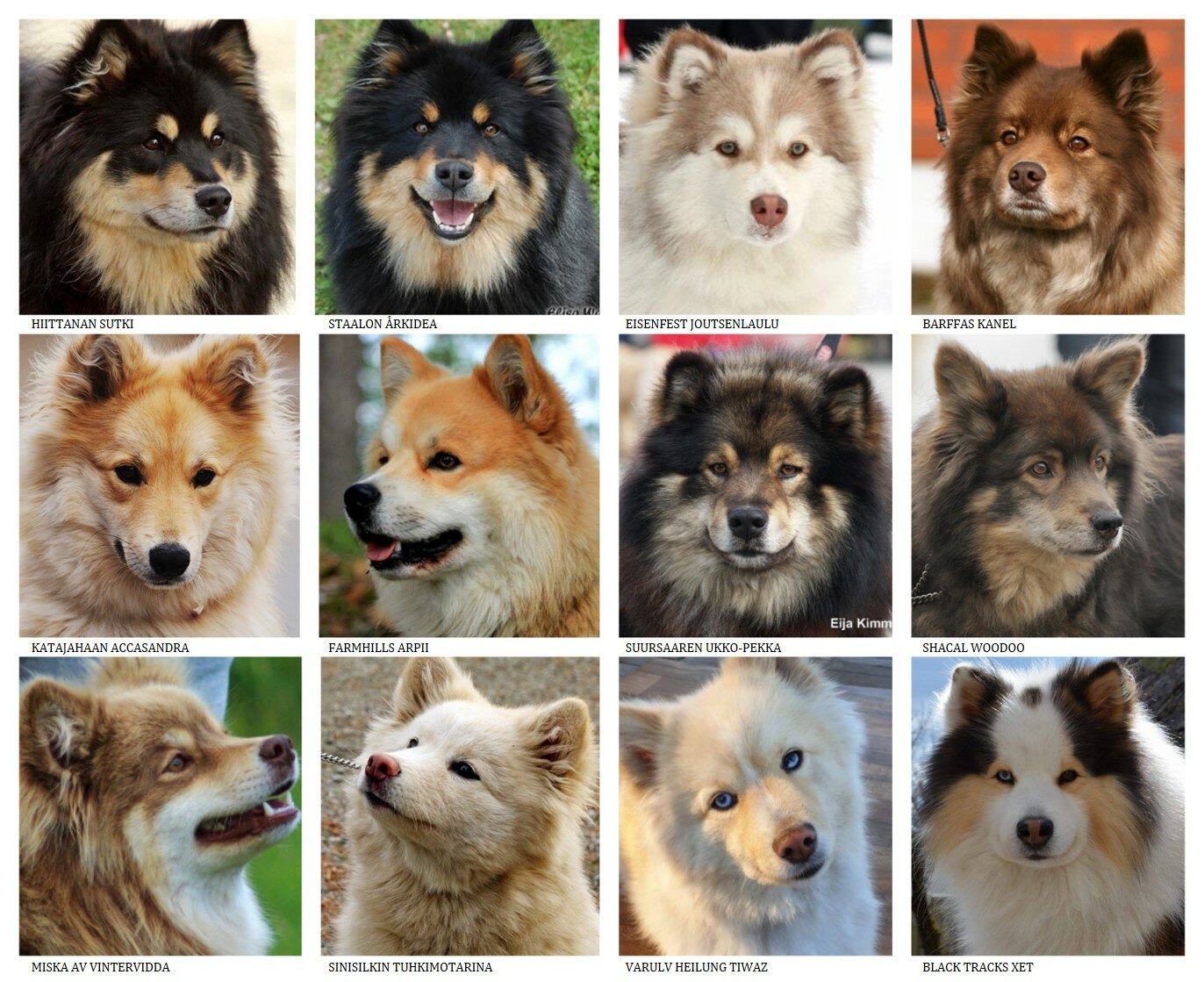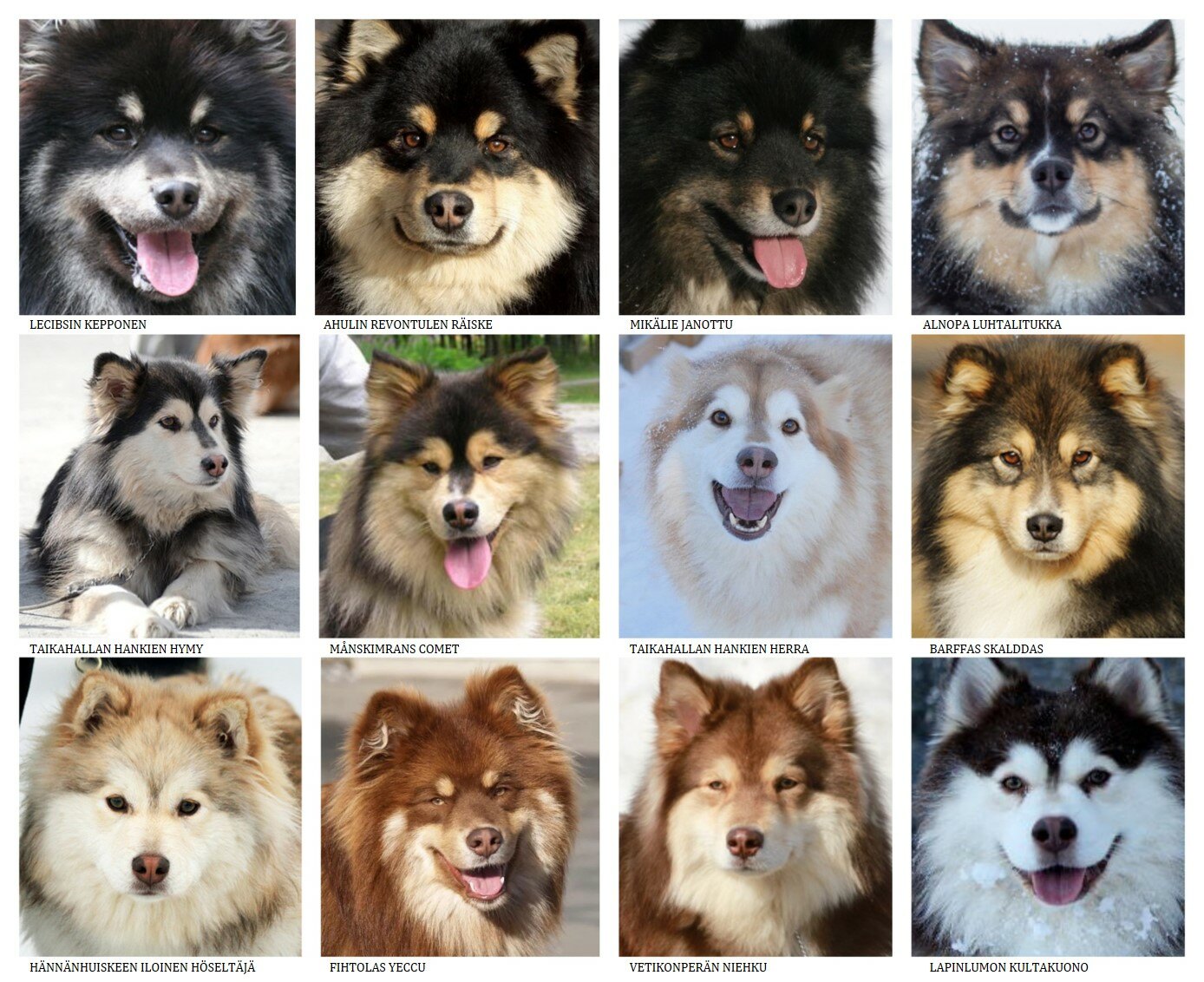Colours of the Finnish Lapphund - A Rainbow of Possibilities
Please Note: we last updated the pictures on this page (2021). Any errors, or corrections please let me know.
Update to come: Intensity Gene - influences the intensity of tanpoint, sable, cream and possibly undercoat colouring
Finnish Lapphunds come in almost every colour of the Canine Rainbow and are one of the most diverse breeds when it comes to recognised colours.
They start with the base pigments eumelanin (Black) and pheomelanin (White), then combine additional genetics for colours: Brown, Blue and Lilac; and patterns: Sable, Agouti (Wolf Sable), Tanpoint, Solid, Domino, with or without white markings.
The appearance is further enhanced by the size, shape and position of the ears, the colour and shape of the eyes, the pigment on their nose, eyerims and lips as well as the length, density and texture of the coat.
Undesirable Colours include parti-colour, brindle and saddleback (think German Shepherd/Beagle). These colours have all but been eliminated in show lines with only the occasional appearance these days.
Merle does not exist in the Finnish Lapphund nor does the Greying gene (mostly seen in Bearded breeds and some terriers which causes them to become overall lighter in colour as they mature).
Black - (B Loci) Black with tanpoint markings is easily the most well known and recognised colour for the breed. Tan intensity varies from palest cream to deep caramel. Solids may have white markings and spectacles. White markings should not be confused with very pale tanpoint. Ullastiina Felix, Staalon Ex Tempore and Pörröpöksyn Karva-Kamu are the only 3 solid blacks in the group below.

Brown - is recessive to Black, meaning it needs to be inherited from both parents. Brown Finnish Lapphunds are found in various shades, with or without Tan and White markings the same as black above.
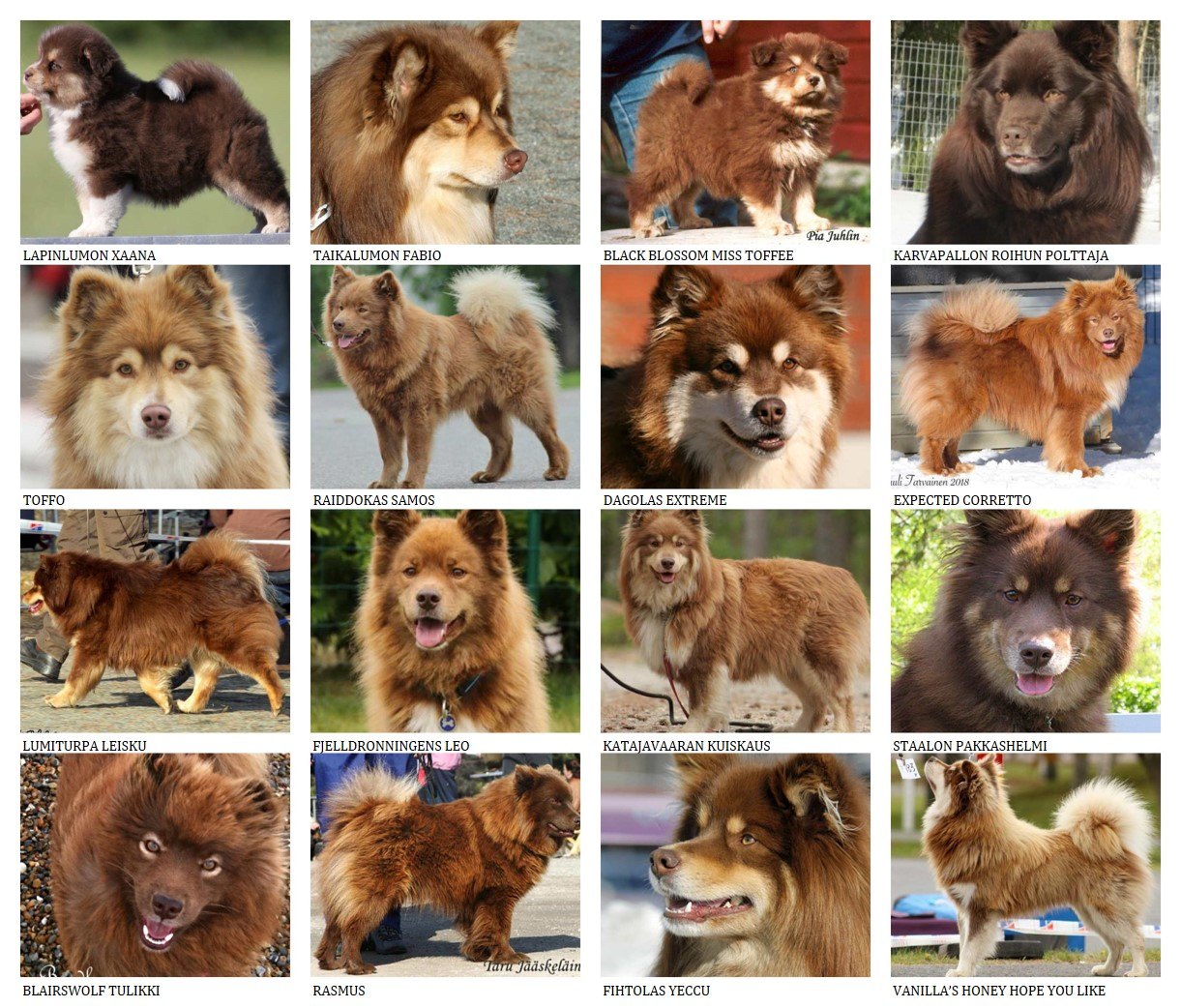
Cream - recessive inheritance, meaning it's inherited from both parents. Although it's recessive, Cream masks every other colour. The pigment on nose, eyerims and feet giving away the base colour of Black, Brown or even dilutes. Under cream, they may be hiding sable, wolf sable, tanpoint or solid patterns. The intensity of cream is the same as for tanpoint, as the gene responsible for both is (very simply put) the same. Pigment often fades on Cream Finnish Lapphunds, and even more so over the winter. The first two rows below are black based creams. The bottom two rows are brown based creams.
Dilute - Blue. two copies of the recessive Dilute gene on a Black dog produces Blue. Whilst fairly obvious in a puppy, as adults it's often more difficult to distinguish between Black and Blue. Puppies are pictured here together to show the difference. This colour is uncommon.
Dilute - Lilac. two copies of the recessive dilute gene on a Brown dog produces Lilac. Due to the recessive nature of both Brown and Dilute, this colour is also uncommon.
Sable (Ay) (Black) - Dominant inheritance meaning the dog only needs one copy of Ay to be Sable. Sable Finnish Lapphunds range in colour from the palest cream to deep red/orange. Black or Brown pigment and sable tips gives away the base colour. The pigment is often (but not always) retained and doesn't fade over time like it does on Creams. Sable can confuse people when they're looking at a red/cream/brown-ish colour dog and are told its 'Black' Sable. The intensity of the phaeomelanin which can make them appear cream or brownish is controlled by a different gene.
Sable (Ay) (Brown) - Sable inheritance is dominant, but brown is recessive. Again the colour intensity varies but the brown tips and pigment give away the brown base colour. These can be much harder to identify but a parent should be Sable in order to produce Sable. (Dominant Solid or Cream can, of course, mask Sable)
Theoretically Sable can also come in both dilute Blue and Lilac and i'm sure they exist, but I haven't been able to confirm any. Yet.
Wolf Sable (Agouti - Aw) - Black. You only need one copy of Aw from one parent to produce Wolf Sable. Wolf Sable dogs range in colouring and can be seen with and without the tanpoint face mask. Suprisingly, they can also be seen with tanpoint masks but without the signature eyebrow pips. The cause for this is not known. The first pictures are the same bitch as a puppy and adult to show the progression of colour. These are more obvious examples of Wolf Sable but the actual colour can be difficult to identify at birth and again as adults as the sable (black tip) guard hairs can cover the body, giving the appearance of a Black and Tan dog.
Wolf Sable (Agouti - Aw) - Brown. Wolf Sable is dominantly inherited but Brown is recessive which can make this colour combination less common. There are many registered 'Brown' Lappies who are suspected to actually be Brown Wolf Sable. The wolf sable can sometimes be hard to detect, especially on an adult.
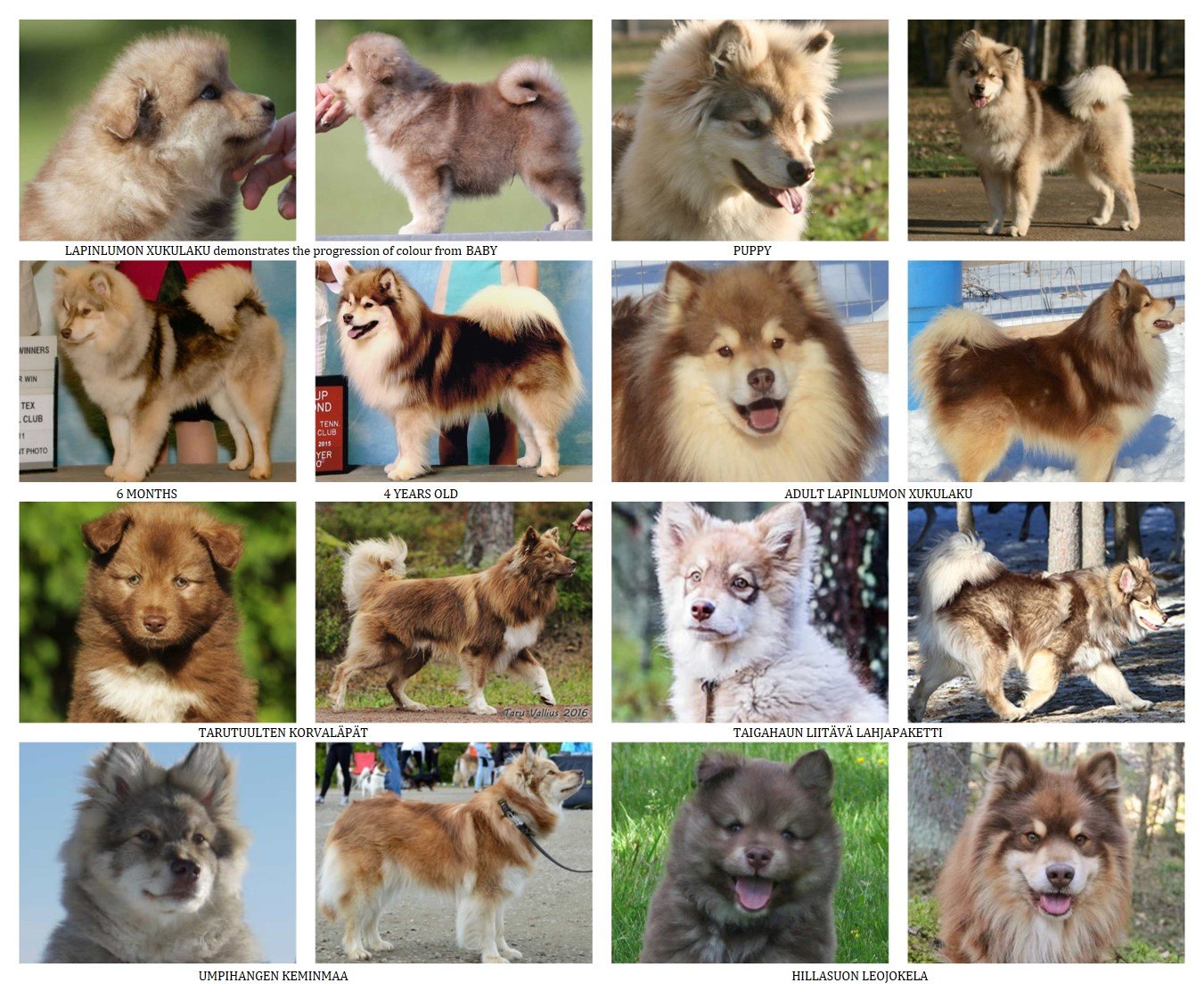
Wolf Sable (Aw) - Dilute - These photos attempt to show the progression of the colour as the dog matures. I haven't yet found a Lilac Wolf Sable. I suspect it may sometimes pass undetected or be labelled Brown as the colouring is not always as obvious. Dilute and Wolf Sable seems a reasonably uncommon combination and may be harder still to identify on an adult as the colour darkens with age.
Domino (Black) - is a recessively inherited pattern that affects the expression of the base colour (black, brown, dilute). This pattern is apparent at birth, usually with a telling, clear mask on the face. The colour and shading varies greatly. Similar to Cream and on the same Locus, domino actually alters the appearance of the other colours by applying a base colour (black, brown, dilute) pattern overlay.
Domino (Brown) - less common than Black as you need a pair of recessive brown genes, but more common than Domino Dilute (Blue and Lilac). In Domino you're looking for the colour of the tips, not to be confused with the cream/caramel tanpoint markings. The puppies in the first photo somewhat demonstrate the difference with the two centre 'black' domino's and the outer 'brown' domino's.
Patterns and markings - Irish Spotting White markings which can occur on any other colour - usually on chest, legs and feet. Can extend to the face, back of neck or even a full collar. Full body white with patches of colour are not desirable for the show ring and are uncommon.
Patterns - Saddleback - Difficult to detect on a puppy but as it has dominant inheritance is somewhat easier to predict as it will come from a parent. Deemed an undesirable colour several decades ago and so has become increasingly uncommon. This pattern is unlikely to be produced in Australia.
Patterns - Brindle - dominant inheritance. Another undesirable colour in Finnish Lapphunds and so it's unlikely to be produced in Australia.
The brindle pattern is seen on sable dogs, or where the tanpoint would be, so it can be missed on a dog with minimal points. We've included some more obvious examples here
Masks and Spectacles - The traditional signature look of the Finnish Lapphund includes a tanpoint mask. Some are full and bright with clear edges, others are less distinct. Finnish Lapphunds can also develop spectacles around the eyes. These can be in addition to a mask or entirely separate. Every pattern and variation is equally accepted and no one look is 'better' than another.
Ears - Tipped - Adult Finnish Lapphunds occasionally have tipped (or slightly folded) ears. It is equally acceptable for an Adult Finnish Lapphund to have both ears erect, or for one or both ears to have the tips slightly folded over. These are examples of non-erect ears. Dropped ears can be a sensitive topic for owners/breeders, so I deliberately chose correct ears here so as not to upset anyone.
I am not weighing in on how high is correct or how dropped an ear should be before its penalised. Thats for a judge, owner and breeder to determine.
Almost all puppies arrive in their new homes with their ears still floppy and folded over. It can take several weeks to several months for the ears to climb or pop up and they often drop again during teething as a sign of pain.
Eyes - Eye colour should be as brown as possible. Whilst dark brown eyes are considered the ideal, coat colour affects the shade of colour with Brown, Wolf Sable and Dilute colour Lappies often (though not always) having a lighter eye, though usually complementing the coat colour. Occasionally 1 or both eyes are blue. This may be connected to White Spotting, though it's also known to occur independently, similar to what occurs in Siberian Husky's. Unlike Husky's, blue eyes are not sought after in a Finnish Lapphund and its usually a surprise to breeders when it occurs.
Snow Nose - A paler stripe down the centre of the nose leather with less pigment. The intensity can vary. Most often seen on Domino but can occur on any dog. In some cases only noticeable in Winter (linked to less sun exposure) and is quite common in Spitz breeds.
The Genetics.
Genes are all tied together into a long strand of DNA. A gene is basically a set of instructions which tells the cell how to produce certain proteins (pigment, in this case). The genetic make-up of a dog is its genotype. The physical appearance of the dog is its phenotype. Genes are made up of two Allele's: one from each parent. Each point on the strand of DNA is called a locus. A 'locus' (plural 'loci') refers to the specific location on the DNA where the gene is found.
Finnish Lapphunds, like most dog breeds, carry loads of genetic markers, we're just going to deal with the main colour loci here. For more information on colour genetics, visit Dog Coat Colour Genetics
The combined effect of the 4 major loci (A, B, E and K) is the colour of the dog. Due to the complex interactions of these genes, it is possible for dogs to carry hidden colours which may appear in their offspring.
The E Locus hosts 8 variants with 4 known to exist in Finnish Lapphunds. 'E', 'eg' (domino), 'ea' (domino) and 'e'. If a dog is 'ee' the dog will be cream (can be shades of yellow and red) and everything on the other loci is hidden until the next generation. If the dog has one copy of 'E' it will not be cream and you look at the next loci to determine colour.
The K Locus has 3 known variants. 'K' also called 'KB' is dominant solid colour. If the dog has even one copy of 'KB' the dog is solid and everything on the A locus is hidden until the next generation. 'Kbr' is brindle which exists in our breed but is uncommon and 'ky' means there's no influence from the K loci and we proceed to the next loci to determine colour. All 3 variants are present in Finnish Lapphunds, though they're mostly 'ky'.
The A locus has 4 variants, all present in Finnish Lapphunds. 'Ay' is sable the most dominant, 'aw' is wolf sable. 'at' is tanpoint and 'a' is recessive solid. Any dog which has at least one copy of 'Ay' will be sable and any dog that is 'aa' will be black. If not 'Ay' and at least one copy of 'aw' they will be wolf sable. If the dog is 'at/at' or 'at/a' they will have tan points. Consider the A locus to determine how much black will be allowed to express; the higher up the dominance, the less black allowed to appear. The lower the dominance, the more black will be visible.
The B locus has 2 variants. 'B' Black and 'b' brown. A dog which is "bb" will have brown fur in those areas that would otherwise be black. Brown is caused by at least 4 different mutations. Finnish Lapphunds have at least 3 of them.
The D locus is also relevant to Finnish Lapphunds and is the Dilution Loci. There are 2 variants. Non-Dilute 'D' and dilute 'd'. Dogs which are "dd" have "Blue" fur in place of black, and "Lilac" in place of brown.
Another way of putting it:
E Locus
2 of the following Allele's will be passed on to a puppy:
E - Normal (K and/or A locus will be expressed)
Eg - Domino (Sighthound type) Eg has been found in several Lapphunds so we have at least 2 types of Domino in our breed.
Ea - Domino (Ancient type) A test was recently developed to find 'Ea' domino in Lappies.
(Eg/Ea are recessive to E and dominant to e but their dominance towards each other is unknown at this time.)
e - Cream (when a dog inherits 'ee' this gene suppresses all other colours)
K Locus
2 of the following Allele's will be passed on to a puppy:
KB - Dominant solid (B locus determines whether solid Black or Brown) Proven in Finnish Lapphunds by DNA but not believed to be common.
Kbr - Brindle -currently can't be DNA tested for but is known to exist on the K Locus.
ky - recessive non-solid (A locus will be expressed)
A Locus - Agouti (markings)
2 of the following Allele's will be passed on to a puppy:
Ay - Sable - Only one copy needed to make a puppy Sable
aw - Wolf Sable - Only one copy needed to make a puppy Wolf Sable as long as the other allele is at or a
at - Tanpoint - The only possible combinations of a Tanpoint dog are at/at and at/a
a - recessive solid - two copies needed in order to be recessive solid
B Locus (base colour)
2 of the following Allele's will be passed on to a puppy:
B - Black. If the puppy inherits one B means the puppy can not be Brown.
b - Brown (comes in 3 known variations and at least 1 more unknown - Finnish Lapphunds have been proven to carry all 3 known variants).
D Locus (Dilute)
2 of the following Allele's will be passed on to a puppy:
D - Normal If the puppy inherits one D the puppy cannot be Dilute
d- Dilute
Rules
There are a couple of rules. The rest are so dependent on the combination that it's too complicated to try to list them all here.
1. Recessive 'ee' trumps every other colour and the dog will appear Cream. Domino 'Eg' or 'Ea' trumps everything but ee.
2. If the dog inherits even one KB allele then the dog will appear solid colour (black or brown), unless Rule 1 applies.
3. If the dog inherits even one Ay they will appear Sable, unless overwritten by Rule 1 or Rule 2
4. If the dog inherits even one Aw they will appear Wolf Sable, unless overwritten by Rule 1, 2 or 3
and so on....
Other Colours/Markings
Colour genes we appear to have but which I haven't discussed here yet include Urajiro, Ticking and Melanistic masks (these seem uncommon).
The S gene deals with Spotting including piebald and possibly Irish/White Spotting.
Also not covered but discovered in 2019 is the Intensity gene. Thats a future update and applies to the colour intensity variations in the 'tan/cream' colour.
There are still plenty of things we are yet to uncover about Lappie colour genes such as the presence or absence of a lighter undercoat which can make an adult coat colour harder to identify, and vary the appearance of the dog throughout the year.
Limitations
Of course, a parent can only pass on what they themselves have to give, so for example, you won't get a Wolf Sable (Aw) dog from two Black and Tan (At) parents
Further Reading
Clear as mud? Don't worry, it can take a while to wrap your head around it. In the meantime, the Dog Coat Colour Genetics page is a great resource for plain speaking explanations of colours and inheritance (Still not updated with latest ASIP testing).
UC Davis also known as Vetgen provide a Colour Test. Within the link, each Heading goes to a page delving into the genetics of each locus.
If you're ready to tackle the new ASIP (A Locus) Testing, you can learn about it here.
